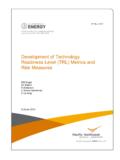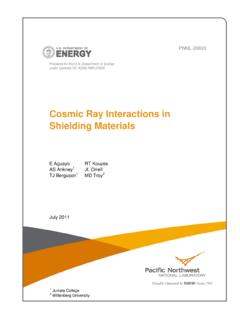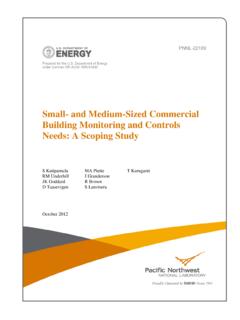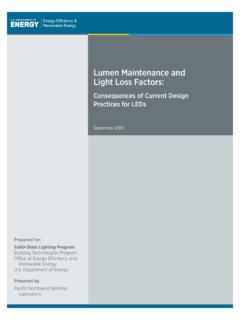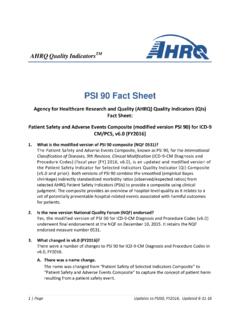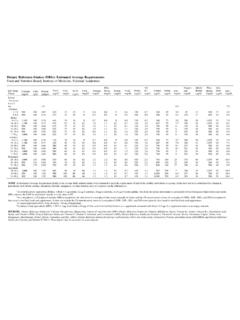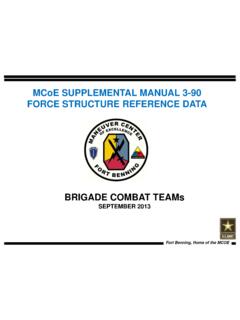Transcription of ANSI/ASHRAE/IES Standard 90.1-2016 Performance Rating ...
1 PNNL-26917 ANSI/ASHRAE/IES Standard Performance Rating Method reference Manual S Goel M Rosenberg C Eley September 2017 PNNL-26917 ANSI/ASHRAE/IES Standard Performance Rating Method reference Manual S Goel M Rosenberg C Eley1 September 2017 Prepared for the Department of Energy under Contract DE-AC05-76RL01830 Pacific Northwest National Laboratory Richland, Washington 99352 1 Eley and Associates iii Acknowledgments This document was prepared by Pacific Northwest National Laboratory (PNNL) for the Department of Energy s (DOE s) Building Energy Codes Program. The authors would like to thank the following organizations and individuals: Commercial Energy Services Network (COMNET) team for developing the framework for thisdocument through the Standard Commercial Building Energy Modeling Guidelines andProcedures.
2 California Energy Commission (CEC) for providing guidance through the Nonresidential AlternativeCalculation Method (NACM) reference Manual. The reference Manual has been built off workoriginally done by COMNET for the Standard Commercial Building Energy ModelingGuidelines and Procedures and by CEC for the NACM reference Manual. American Society of Heating, Refrigerating, and Air-Conditioning Engineers (ASHRAE) Standard Project Committee (SSPC) for their insight. The external peer review team and advisors:Maria Karpman, Karpman Consulting Matt Swenka, The Weidt Group Andrew Parker, National Renewable Energy Laboratory Chris Balbach, Performance Systems Development Fred Betz, Affiliated Engineers Sagar Rao, Affiliated Engineers Gail Hampsmire, Green Building Certification Institute Roger Hedrick, Noresco Michael Patterson, Trane Fred Porter, Noresco William Talbert, MEP Associates, LLC Matt Wilburn and Mark Halverson at PNNL for editorial and technical reviews.
3 David Cohan, Amir Roth, Jeremiah Williams at DOE Bing Liu, Manager of the Building Energy Codes Program at PNNL v Acronyms and Abbreviations ACH air changes per hour AFUE annual fuel utilization efficiency AHRI Air-Conditioning, Heating and Refrigeration Institute AHU air handling unit ANSI American National Standards Institute ARI Air-conditioning, Heating and Refrigeration Institute ASHRAE American Society of Heating, Refrigerating and Air-Conditioning Engineers ASTM American Society for Testing Materials BDL building design language C-factor thermal conductance CCF centum cubic feet CEC California Energy Commission CRRC Cool Roof Rating Council CFA conditioned floor area cfm cubic feet per minute CHP combined heat and power CHW chilled water COMNET Commercial Energy Services Network COP coefficient of Performance DCV demand controlled ventilation DDC dynamic demand control DOAS dedicated outdoor air system DV displacement ventilation DOE Department of Energy DX direct expansion EA effective aperture Ec combustion efficiency EF energy factor EER energy efficiency ratio EFLH equivalent full load hours EIA Energy Information Administration EILP exterior installed lighting power EIR energy input ratio ELAP exterior lighting power allowance ERV energy
4 Recovery ventilator Et thermal efficiency vi F-factor heat transfer coefficient of a slab edge unit of perimeter length FPLR function of part load ratio FT function of temperature HSPF heating seasonal Performance factor HVAC heating, ventilation, and air conditioning HW hot water IES Illuminating Engineering Society ILPA interior lighting power allowance kBtu/hr thousand British thermal units per hour LPD lighting power density MBH thousand British thermal units per hour MCF thousand cubic feet MBtu thousand British thermal units MJ megajoule MMBtu million British thermal units NACM Non-residential Alternate Calculation Method NAECA National Appliance Energy Conservation Act NFRC National Fenestration Rating Council OA outdoor air OAT outdoor air temperature PAF power adjustment factor PFP parallel fan powered PIU powered induction unit PLF part-load fraction PNNL Pacific Northwest National Laboratory PSZ-AC packaged single zone air conditioner PTAC packaged terminal air conditioner PTHP packaged terminal heat pump PRM Performance Rating Method PVAV packaged variable air
5 Volume RCR room cavity ratio RDP relative daylight potential SAT supply air temperature SEER seasonal energy efficiency ratio SHGC solar heat gain coefficient SO source orientation SRR skylight roof ratio SSPC Standing Standard Project Committee vii TOU time of use U-factor thermal transmittance UFAD underfloor air distribution system UMLH unmet load hours VAV variable air volume VRP ventilation rate procedure VT visible light transmittance W watt water column WSHP water source heat pump WWR window-to-wall ratio ix Contents Acknowledgments .. iii Acronyms and Abbreviations .. v Overview .. Purpose .. Applications of the PRM-RM .. Standard Performance Rating Method Compliance Calculations .. Organization .. Type of Project Submittal .. General Modeling Procedures .. General Requirements for Data from the User.
6 General .. Definition of Building Descriptors .. Treatment of Descriptors Not Fully Addressed by this Document .. Regulated and Unregulated Energy Use .. Thermal Blocks, HVAC Zones, and Space Functions .. Definitions .. Modeling Requirements for Zones .. Required Zone Modeling Capabilities .. Modeling Requirements for Unconditioned Spaces .. Modeling Requirements for Parking Garages, Attics, and Crawlspaces .. Modeling Requirements for Semi-Heated Spaces .. Space Use Classification .. Unmet Load Hours .. Calculation Procedures .. HVAC Capacity Requirements and Sizing .. Specifying HVAC Capacities for the Proposed Design .. Sizing Equipment in the Baseline Building .. Proposed Design with No HVAC Equipment .. Building Descriptors reference .
7 Overview .. HVAC System Map .. Organization of Information .. General Information .. Building Model Classification .. Geographic and Climate Data .. Site Characteristics .. x Calendar .. Simulation Control .. HVAC Zones .. General Information .. Interior Lighting .. Receptacle and Process Loads .. Occupants .. Natural Ventilation .. Thermal Mass .. Space Uses .. General Information .. Occupants .. Interior Lighting .. Daylighting Control .. Receptacle and Process Loads .. Commercial Refrigeration Equipment .. Elevators, Escalators, and Moving Walkways .. Gas Process Equipment .. Building Envelope Data .. Building Orientation .. Materials .. Construction Assemblies.
8 Roofs .. Exterior Wall .. Exterior Doors .. Fenestration .. Below-Grade Walls .. Slab Floors in Contact with Ground .. Heat Transfer between Thermal Zones .. HVAC Zone Level Systems .. Zone Temperature Control .. Terminal Device Data .. Terminal Heating .. Baseboard Heat .. Zone Level Airflow .. HVAC Secondary Systems .. Basic System Information .. xi System Controls .. Fan Outdoor Air Controls and Economizers .. Cooling Systems .. Heating Systems .. Humidity Controls and Devices .. HVAC Primary Systems .. Boilers .. Chillers .. Cooling Towers .. Fluid Economizers .. Pumps .. Thermal Storage .. Heat Recovery Plant Management .. Miscellaneous Energy Uses.
9 Water Heating .. Swimming Pools .. Transformers .. Exterior Lighting .. Other Electricity Use .. Other Gas Use .. On-Site Power Generation .. Photovoltaic Systems .. Wind Systems .. Common Data Structures .. Schedule .. Holidays .. Surface Geometry .. Opening Geometry .. Opening Shade .. Construction Assembly .. Fenestration Construction .. Material .. Slab Construction .. Exterior Surface Properties .. Occupant Heat Rate .. Furniture and Contents .. reference Position in a Space .. xii Two Dimensional Curve .. Three Dimensional Curve .. Temperature Reset Schedule .. Energy Price Data .. State Average Energy Costs .. Custom Energy Costs .. Utility Costs: Tariffs .. Utility Costs: Charges.
10 Utility Costs: Ratchets .. Reporting .. Content .. Building Summary .. Performance Outputs .. Model Input Documentation .. Representations .. Supporting Documentation .. Format of Report .. References .. xiii Figures Figure 1. Information Flow .. Figure 2. Hierarchy of Space, HVAC Zones, and Thermal Figure 3. Calculation Process for Standard Performance Cost Index Using Performance Rating Method .. Figure 4. Example Stepped Daylight Control .. Figure 5. Example Dimming Daylight Control .. Figure 6. Single Maximum VAV Box Control (Courtesy: Taylor Engineering) .. Figure 7. Dual Maximum Control Sequence .. Figure 8. Single Maximum Control Sequence for Parallel Fan Powered VAV with Reheat Boxes .. Figure 9. SAT Cooling Setpoint Reset based on Outdoor Air Temperature (OAT).





